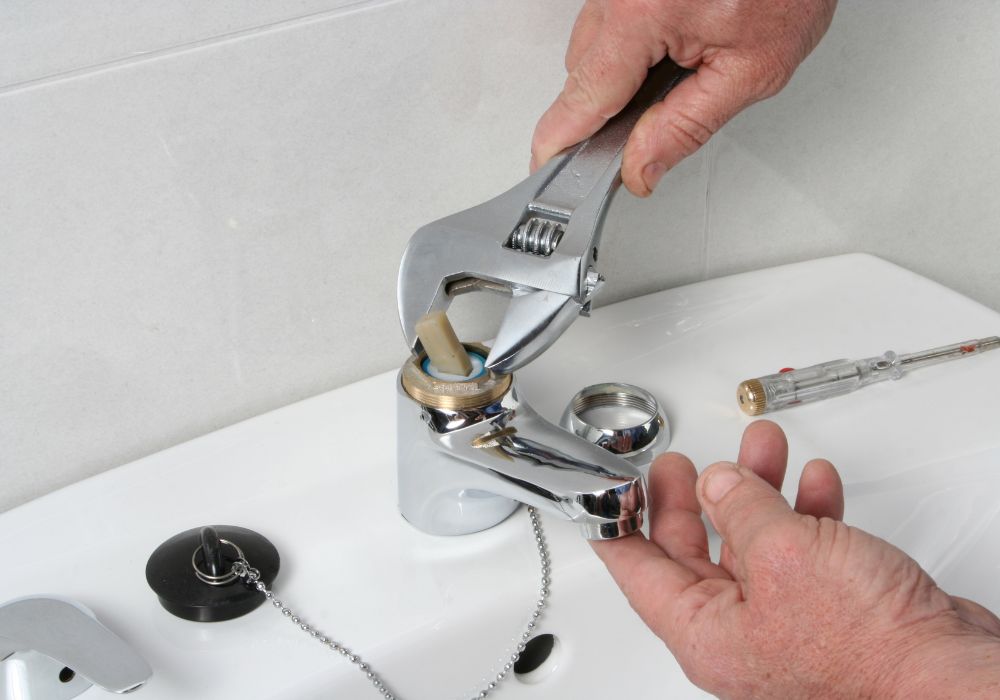Your kitchen faucet leaks at the base because it is rusted, has a damaged rubber washer, a faulty valve seat, and is broken or loose O-ring. A shabby and exhausted O-ring seal is typically the cause of the water leak.
Even when you turn off the faucet, it can still leak due to a mineral deposit that breaks its cartridge or has broken or clogged pipes.
Why Is The Kitchen Faucet Leaking At The Base?
A kitchen faucet has O-rings as seals to be watertight unless it is turned on. This will ensure that water inside the pipes only runs and circulates through the spout.
Water flowing from the base of the faucet means there is a problem with the tap. If a faucet leakage from the bottom, it is because the O-rings are worn out or it has debris that prevents the faucet from making watertight seals.
You have a defective cartridge If the leak continues even when the tap is turned off.
Aside from the reason mentioned earlier, other possibilities cause the problem in your faulty and leaking kitchen faucet. Some of them are:
- Loose kitchen faucet base
- Malfunctioning kitchen faucet
- Worn-out O-ring
- Faulty washer
- Valve issue
How Do I Stop My Faucet From Leaking From The Base?

When turned on, you must replace or clean the O-rings to fix your kitchen faucet leaking from the base.
However, you must replace the cartridge if the faucet drips endlessly, even when turned off. To fix this successfully, you must determine three things to save time and money.
- What is the brand and type of your faucet?
- How does your faucet leak from the base: when turned on or even off?
- Is your faucet a single-handle kitchen faucet or a double-handle kitchen faucet?
Identify your kitchen faucet manufacturer’s logo or brand and look for its model number. Determining it will determine if you need to buy replacement parts.
You are more likely to replace the O-rings or, sometimes, the cartridge. A single faucet can have one or two O-rings commonly installed on the stem in a single-handle faucet and the spout in a double-handle faucet. And faulty O-rings will cause the water to flow out of its cartridge.
1. Fixing a Double-Handle Kitchen Faucet Leaking from the Base
Double-handle kitchen faucets usually have 1 O-ring or 2 O-rings that are found on the spout. The O-rings replacing the O-rings in double-handle kitchen faucets is way easier.
Step 1. Disconnect the Faucet Spout
Look at the bottom part of the faucet using a collar for the spout. This step will need a pair of pliers to loosen the collar and a towel to wrap around it and grab it with the pliers. Loosen it and pull the spout straight up.
Step 2. Replace the O-rings
Replacement Seat Springs and O Rings For Faucet.
Reveal the O-rings by pulling the collar all up the spout. Consider cleaning and reusing them if they are dirty but still in good condition.
Remove the O-rings with a sharp knife or flathead screwdriver and prepare the grooves with rag and grease. Position the O-rings inside the tracks and apply some oil around them.
Step 3. Install the Faucet Spout
That is how to install the faucet spout. Push the tap down on the faucet until you hear a click. Screw the collar with your hand while tightening it further with the pliers.
Remember to use the towel as you peel off the finish. Check if the leak has stopped.
2. Fixing a Single-Handle Kitchen Faucet Leaking from the Base
You will only take 10 minutes or less to fix the leaks and damages in your faucet. Before you start your task, prepare these tools and materials: a sharp knife or a small flathead screwdriver, the replacement O-rings, slip-joint pliers or adjustable wrenches, and a kitchen towel or hand towel.
These are the steps on how to fix a leaking single-handle kitchen faucet.
Step 1. Remove the Faucet Handle
Remove the hex screw hidden by a small plastic cover underneath the handle using a flathead screwdriver or knife. Then, manage and loosen the screw using an Allen Wrench. Removing the hex screw out can result in dropping it down the drain and missing it.
Step 2. Remove the Spout
Begin the second step by detaching the dome or collar. A crown or a round collar holds the spout tightly in place; most of the time, it is threaded or pushed down.
Next, all you have to do is pull the fixture out. With a wrench or pliers, grab and loosen it if incorporated.
Wrap a towel around it to prevent scratching it with the pliers. Now, you have to lift off the spout by wiggling it a little while lifting it since the O-rings will hold it.
Step 3. Replace the Faucet O-rings
Cleaning the O-rings may be sufficient to fix the conflict, but I suggest replacing them. Make use of the flathead screwdriver or sharp knife to disconnect the O-rings.
If you want a better tool, you can utilize an O-ring picker. Since you do not intend to reuse them, don’t worry if the O-rings get damaged.
Have a watertight seal by cleaning all dirt and mineral deposits on the O-ring grooves with a rag. Apply grease inside the tracks and around the O-rings if necessary.
Install the new O-rings, and you need to loop a string through it to expand it as you go over the cartridge. You can pull out the string once the O-ring is in the groove.
Step 4. Connect Back the Spout and Handle
Clean the inside of the spout’s neck, too, and remember to seal at the top of the spout neck. Apply some grease on it as well. You have the new O-rings now, so you must force the spout over by pushing it down without harming it.
After connecting the dome or collar back and attaching the handle, the next thing to do is screw in the hex screw. Put the plastic cover back and check if the leak has disappeared.
Should You Silicone Around The Faucet Base?
![]()
Yes, you should put silicone around the faucet base to keep water from escaping and draining through the hole in the kitchen counter.
Prevent further damage to the cooktop or sink by doing this. Placing silicone is a remedy to keep grime and other contaminants from getting inside the faucet or the surface around it.
Silicone is a sealant that safeguards the faucet and stops it from loosening over time. But how do you seal the base of a tap?
- Turn off the faucet or the water supply.
- Use a Crescent wrench or an adjustable plier to unhook the nuts that connect the faucet to the sink.
- Using a putty knife, jam the existing sealant around the neck or base plate. Apply a new plumber’s putty or a silicone-based caulk or sealant around the base plate.
- Spread the sealant evenly around the plate.
- Use a damp cloth to wipe away the excess sealant.
- Use the same nuts you loosened to re-attach the faucet to the sink.
- Utilize the Crescent wrench or the pliers to ensure that it fits.
- Turn on the water supply and check if there are no leaks around the base plate of the faucet.
- You can re-apply the sealant or tighten the nuts further if there are any leaks.












